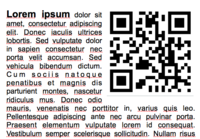 Guest writer Andrew Monti proposes a unique way to use 3D printing in the publishing industry: Fabbed items from books. The idea is to include a QR code somewhere in a book that corresponds to a URL holding a 3D design. The design can then be printed. But how would it work in a book? Andrew writes:
Guest writer Andrew Monti proposes a unique way to use 3D printing in the publishing industry: Fabbed items from books. The idea is to include a QR code somewhere in a book that corresponds to a URL holding a 3D design. The design can then be printed. But how would it work in a book? Andrew writes:In its time, Infocom was a fabulously innovative company. Not only did they develop a core platform for developing interactive fiction (the aptly-named “Z[ork]-machine”), they produced a bevy of incredible adventures, all possessing the highest resolution graphics available – your imagination. As the Infocom designers became more creative, they started developing ‘clue’ books to help their readers through especially frustrating parts of the adventure. Eventually, the designers started including physical objects with their games; buttons, maps, pens, keychains, etc. Some were just for promotion, but some were actually clues vital to completing the game.
Fast forward 25 years, add a touch of fabbing, and voila – fabbed clues! Interactive fiction authors now have a way of adding physical clues to their stories or games without actually having to develop and distribute the objects – not a bad way to generate interest in a new game. Maybe fabbing enthusiasts can join a network where readers without printers can find nearby printer (for a small fee).
This model can be extended to authors of every genre. Here are some ‘fictional’ examples:
- The latest thriller novel can print objects found to enhance the reading experience (and possibly solve riddles)
- Children’s books can print a key object in the story as a keepsake
- Home repair books can print some of the handy parts and tools
- Artists and designers can publish books that can reproduce parts of their art
- Game books can print game pieces and accessories
- Older books can gain new life by being ‘print-enabled’ by including models for objects in the text
Andrew points out that it’s possible such objects might be copied and made generally available, but we think this is not as big a challenge as the object’s value is ultimately tied to the experience of reading the book. Electronic books could simply include the 3D model as an attachment.
We think this is yet another example of the infinite possibilities that are opened up by 3D printing. What do you think of this idea? Would you like to print and touch items from the story you’re reading?

